If a apply a positive Vs, then D2 is blocked and D1 is working, right? How do I calculate Vo then? I know the formula is: - (input resistance / negative feedback resistor) * Vs, but I don't know which exactly is in this case, or in the case of a negative voltage, the input resistance. R2 = R3 by the way. Will the first amplifier be short circuited in the negative voltage case?
2 Answers
Which is the input resistance of the second amplifier?
It's a tad more complex than it first seems. The circuit operates as a precision full wave rectifier and the 2nd stage op-amp is summing two signals: -
- The input signal via \$2R_2\$ and
- An inverted half wave version of the input via \$R_2\$
A version of your circuit is here courtesy of Elliot Sound Products: -
As you can see the final stage sums a negative half-wave rectified signal with the original signal to make a full wave signal.
- 434,556
- 28
- 351
- 777
Basic idea
The circuit is based on a simple arithmetic trick:
During the positive input half wave, only the input voltage Vs is used - Vo = Vs.
During the negative input half wave, two times higher and inverted input voltage (2Vs) is added to the negative input voltage (-Vs). As a result, the negative input half wave becomes positive output half wave - Vo = 2Vs - Vs = Vs.
Thus, in both cases, the output voltage is positive and its magnitude is equal to the magnitude of the input voltage - Vo = Vs.
Implementation
This is what this circuit does... but much more interesting is how it does it... because it is an example of an "ideal" circuit composed of "ideal" sub-circuits. Let's see what they are...
The first op-amp, the two 1 k resistors and the two diodes D1, D2 form an "ideal half wave rectifier" figuratively named "ideal diode". The role of the op-amp is to compensate for the forward voltage drop VF (about 0.7 V) across D1. It does this magic by increasing its voltage by VF (see, for example, this Wikibooks story). Thus, during the positive input half wave, the circuit is actually an inverting amplifier with a gain of -1 and a virtual ground at the inverting input.
The second op-amp, and the resistors R2, 2R2 and R3 form an "ideal" inverting summer. Here the op-amp compensates the voltage drop across R3 by adding an equivalent voltage in series; as a result, another virtual ground appears at its inverting input.
The role of the virtual ground
There are two virtual grounds in this circuit; so it would be interesting to find out what they are for here.
In principle, they serve to isolate sources. For example, during the negative half wave of the input voltage, the first virtual ground (at the inverting input of the left op-amp) grounds the midpoint between the two R1 resistors. Thus it shortens the input source (after the left R1 resistor) and prevents the transfer of input voltage through the path R1 -> R1 -> R2 to the input of the second op-amp. This virtual ground is created by the left op-amp by injecting a current through the diode D2 while the negative input source "sucks" current from this point.
The second virtual ground isolates the input voltage from the output voltage of the half wave rectifier. Thus, each of them determines (through the resistors 2R2 and R2) its own current.
- 13,593
- 1
- 17
- 48

